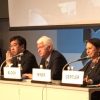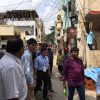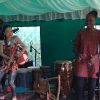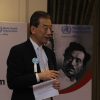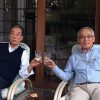I participated in the event, “The Role of the Private Sector in Global Health Security” (Session 2: Facilitating innovation? how to create better environments and systems that support new solutions for global health challenges), at Chatham House on Sep. 28th.
6 Years of HLAB – Helping To Open Doorways to the Future, for the Future, By the Future
HLAB is an initiative that was set up and subsequently maintained by a youthful group of motivated people ( 1, 2, 3).
The founder, Mr. Kobayashi, had shown tremendous grit and determination to bring this organization to where it is now and his achievements over the past six years, particularly in inspiring young people, are note-worthy. And he is eyeing even more success.
This year, they received the Good Design Award (1). Congratulations!!
Although their ambitions are hampered to a degree by limited funds, they find themselves busy all the time.
This summer, for example, they organized a group of university students from around the globe to provide a splendid opportunity for 250 high school students to learn first-hand experiences, while also working on a project to build an experimental greenhouse in Tokyo that maintains a constant climate setting.
The HLAB website is well-designed, offering information in both Japanese and in English. I would like to urge my readers to visit their site and spread the word about their efforts and widen the net of support.
They are also savvy marketers, appealing to a global audience by inviting a group of journalist from abroad to record (scroll down for English) their views and insights into Japan, while also mentioning their activities.
I was also invited to contribute a piece about HLAB, given my involvement from the inception stages.
I firmly feel that is if by supporting such promising initiatives by young people that our generation and the new generation can contribute to changing Japanese society for the better.
I hope you are in, and I look forward to your support!
Supporting a New Generation of Medical Education by Investing in People
On the morning of 18th December, I gave a lecture at the Yayoi Auditorium located in Todai’s (University of Tokyo) campus for the Faculty of Agriculture. This talk commemorated the founding of the Japan Society for Clinical Epidemiology (in Japanese).
It’s good to see an academic society dealing with this kind of topic being formed. I believe it will be indispensable to the education of the future generations of doctors in Japan.
This society was set up by one of the foremost academics in this area, Dr. Shunichi Fukuhara (Kyoto University) (in Japanese) . He has long been involved through the field of epidemiology in mentoring a new generation of doctors.
I believe that Japan’s medical school community has fallen off the pace in recent years by as much as two decades, with its educational system, academic societies, specialist education, and certification processes unable to keep up with the dizzying pace of change that we see across the world today.
The reason why I think so is clear. If you look at my last lecture from 20 years ago at Todai (in Japanese, with summaries in English), or my Plenary lecture at annual convention of Japanese College of Physicians conf (in Japanese) and elsewhere , or my opinions about how the educational curriculum should be (in Japanese), it is a stark reality that nothing has changed.
To mark the launch of this society, I was invited to give a talk. I introduced the audience to some programs that are well-established in the US, from around the 80’s, but are not yet part of the conversation in Japan, along with some initiatives that I started with my fellow researchers.
Here are the slides that I used.
Addressing a Corporate Research Division
Panasonic Healthcare Holdings (U.S website) is a company based in Matsuyama on Shikoku Island, where I gave a talk nearly a decade ago.
Since then, they have parted ways with the parent company Panasonic after investment firm KKR bought an 80% stake, and have bought part of Sanyo Electric Co. Ltd, inviting an outsider, Hidehito Kotani, to take the helm of the company. Recently, Mitsui Co. Ltd has bought 20% of KKR’s stake.
It was to this entirely different company’s Gunma office (in Japanese) that I was invited to give another talk at.
There was a turnout of nearly 500 people, with researchers and engineers from 2 other R&D facilities joining to make a rousing affair.
The questions came thick and fast, and the enthusiasm of the young employees was evident. At the same time, the audience was overwhelmingly male, and there were very few foreigners, one from China asked a question – good thing. I think this is problematic, and indeed can be considered to be a significant weakness.
The gist of my speech? That the company’s departure from the norms and traditions of the company, and the willingness to pioneer changes such as foreign ownership and new governance structures has also trickled down to the employees, creating a vibrancy rarely seen elsewhere. I went on to say that I think it is this ability to depart from familiarity that spurs innovation, and then explained what I meant by ‘innovation,’ before finishing with some observations about the coming years.
It was a rare opportunity to speak at a company’s gathering so I felt good and very excited. To the employees I talked to: please strive to be the best! I am counting on you.
Several Invitations, Talks and Discussions
These days, I have been lucky to be invited to attend several unique parties, receptions and dinners. Barring a few, most were public events, and some were organized by embassies.
Just to give you a general idea, I attended the following events:
Birdlife International’s annual fundraising gala, (the honorary president, Princess Takamado, was unable to attend owing to the mourning for Prince Mikasa’s passing), the commemoration of the creation of the Pasteur Japan Foundation through the collaboration of Institut Pasteur, Tokyo University and Kyoto University, The official unveiling ceremony of the Intilaq Tohoku Innovation Center (in Japanese) by the Qatar Friendship Fund, The Norwegian embassy’s reception for the visit of Norway’s foreign minister, and other events organized by the French embassy, the Swiss embassy, the Dutch embassy, and the British embassy.
At one embassy, I was invited to a small lunch that would be attended by ‘around 10 people’. Turned out that I was the only Japanese invitee, the rest being Minister and the entourage of 5, and the ambassador and his staff. After some small talk, the conversation turned to the current situation in Fukushima after the nuclear disaster, as the Minister sought to learn more. Ever since I headed the NAIIC, I have found myself in similar situations more than few times.
Indeed, I recall that I was once specifically asked for by a visiting foreign dignitary, who was tired of receiving incomprehensible and non-committal replies when he had asked government officials and representatives of Japan about the kind of response Japan was planning in the aftermath of the Fukushima Daiichi Nuclear Disaster. Even taking into account the fact that there may be some errors arising due to translation, the policies of the Japanese government post-Fukushima requires some truly mind-bending and convoluted logic. It is really difficult to explain it in simple terms, probably because there is dissonance between the observations and conclusions. No wonder the hapless government officials were unable to provide reasonable answers. It is disturbing that, although the Fukushima Daiichi disaster ranks right up there as one of the worst nuclear disasters the world has seen, the response cannot be explained to a global audience.
I have written extensively about this worrying issue in the book ‘Regulatory Capture’ (in Japanese), released in March this year. It is not a trifling matter; for it deals with the trust that lies at the heart of national governance.
Meetings, A Lot of Meetings!
My schedule was crowded from the end of September till the beginning of October. I had the meeting of the board of directors of the Okinawa Institute of Science and Technology, a reunion in Tokyo with the President of UCLA Dr Gene Block, followed by the STS Forum in Kyoto (summary of my session is here. where we heard of the news of the Nobel Prize for medicine being awarded to Dr. Osumi.), and then back to GRIPS to attend a seminar by Dr. Colglazier, former Science and Technology Adviser to the U.S Secretary of State.
Next, I flew to Hyderabad via Singapore to chair a meeting of the Board of Directors of the GHIT Fund. We visited some local medical facilities, where I observed and learned a lot of things that may prove useful. It was my first visit to Hyderabad so I had no previous point of reference to compare it to, but recalling my visit to New Delhi ten years ago, I could feel more energy in the air, and the infrastructure was vastly better. I also saw a lot of construction work going for roads and new metro (mass-transit) system.
Although there is still a long way to go before medical facilities are on par with other countries, there are some note-worthy initiatives in place. ASHA, for example, is a bottom-up initiative to ensure that health services are in place even in remote places of India. Along with improvements in infrastructure, clean water supply and telecommunications, this initiative has gone a long way in raising the general standards of health and medical services. I think that these improvements herald a new chapter in public health in India.
On the last day, we had dinner reception at the Taj Falaknuma Palace (1). Incidentally, this hotel has the world’s longest dining table which can seat 101 people. It was a truly luxurious experience.
I felt that there was a stark contrast from what I had been seeing during our field visits. This palace was filled with reminders of a bygone era when the British Empire ruled a large part of the world. I had the feeling that I was being allowed a glimpse into a past when the British were able to rule over a large empire.
Later that night, I took a flight back to Haneda, again via Singapore.
There were also a lot of other meetings, appointments, seminars and lectures, making for a hectic 2 weeks.
The Brilliance of Masayoshi Son, and the 5th Year of His Initiative for Renewable Energy
In the aftermath of the Great East Japan Earthquake, Masayoshi Son laid out a new energy plan for the future, setting up a foundation to conduct research into renewables, and at the same time expanding the boundaries of his corporation to the global scale.
It is hard to find anyone in business circles in Japan, and indeed in the world, who are as capable of generating a buzz and garnering interest as Mr. Son. It is easy to criticize and be a naysayer, but I wonder how those same critics will fare in the face of similarly fierce put-downs.
Son-san has not taken long in acting to make his new energy plan, a response to the Fukushima Daichi Nuclear Accident, a reality.
On 9th September, I was invited to take part in a panel discussion as part of a conference organized by his foundation. You can view the panel discussion through this link to the foundation’s website, as well as comment or ask questions.
The speeches of Kåberger, Dr. Lovins (at around 14 min) and Son (at around 43 min, as well as from the beginning in the second video) were all wonderful, inspring and informative. I was particularly impressed by the comprehensiveness of Son’s vision, his thoughts and views, and his ability to translate thought into action, as well as the structure of his talk. His answers to questions were also very good.
If you see his video, you will be able to understand the precarious position that Japan is in, as it is left behind in the wake of of world-movers like the US and China who change the world that we live in through their decisions and the policies that they make.
It really saddens me that the people who are in charge of energy policy in Japan, and are therefore responsible for the future of Japan, are too small-minded to participate in global debates, content instead with just looking as the rest of the world seeks change.
There is a lot of potential for new enrgineering and technologies within Japan, but so long as they are not utilized and, they will remain as they are, only potential dreams.
The Fukushima Daichi Nuclear Disaster is an accident of proportions that will remain for centuries, yet there appears to be little desire to learn from it, no major movement or indication that a definitive master-plan will be in sight.
It seems we will only be getting more of opportunistic politicians and media belonging to the ‘ruling elites and establishments’, and the researchers who support on-going agenda. Perhaps this is all part of the mindset of a ‘remote and isolated Japan’ ?
It appears that Japan’s energy policy will remain under Regulatory Capture for the foreseeable future. I had requested my publishers to prepare some copies of my book ‘Regulatory Capture’ to sell here just in front of the cofenerce hall, but the demand was beyond expectations and the book copies were sold out very quickly (in Japanese) thanks to an eager audience.
Participating in the TICAD6 in Nairobi – 3
After the Noguchi Hideyo Africa Prize workshop, I went to a nearby hotel where a conference on Non-communicable diseases (NCD) was being held. I made good on a promise to deliver the keynote speech. After this talk, there was a panel discussion, which I had to leave halfway through (the audience was made up of mainly medical professionals, and I received emails congratulating me on the unexpected but important nature of my talk) to get back to the Hilton in order to attend the GHIT meeting in the afternoon.
Here at this GHIT Fund meeting, Dr. Greenwood and Dr. Coutinho, recipients of the Noguchi Africa Prize, were also on stage, making the proceedings very lively. I arrived when the panel was already wrapping up, and after the closing words, we headed out to the poolside of the Hilton Hotel where the GHIT Fund had prepared a reception.
The special artist invited to perform during this reception evening was Anyango. She is a young Japanese woman who went to Kenya to learn more about the particular African music and instrument that had so captured her imagination. After years of hard work in an apprenticeship, she became proficient enough to earn the right to play instruments, a right traditionally held by men.
She had already been on worldwide tours to promote her music, with several albums to her name. When I had inquired to her managing office in Tokyo, they told me that she was scheduled to be in Kenya during the later weeks of August, which was perfect timing, so I put in a request for her to perform.
Anyango performed with a local band, and as the performance progressed, some of our guests from African contries, went from singing together to dancing, making it a memorable evening.
Recently, she was featured in a TV program in Japan.
After the reception, I spent some time unwinding with the people of the Cabinet Office over dinner, a small gesture of thanks for all the hard work that we had put into the Workshop. I also met some of the delegates from Japan.
It was a nice ending for an enriching and thought-filled time spent in Nairobi.
Participating in the TICAD6 in Nairobi – 2
As I wrote in my earlier post, the symposium of the Hideyo Noguchi Africa Prize, where I am the chair, was held at the Nairobi Hilton on the morning of 26th August.
The symposium was attended by three of the past four recipients of this award from the years 2008 (1st) and 2013 (2nd). Indeed, we relied heavily on the help of Dr. Miriam Were, who was one of the first recipients of this award, to get the cooperation of WHO-AFRO in organising this workshop.
Also, given the nature of the Hideyo Noguchi Africa Prize and its emphasis on public health of Africa, I made a special request Dr Were to invite young people who work in this area.
One of the defining features of the Noguchi Africa Prize is the emphasis on both public health and epidemiology and in medical research relevant in the African continent,. Thus, past laureates include people like Dr. Were from Kenya and Dr. Coutinho from Uganda. These two in particular are wonderful role-models for aspiring young African people, and are held in high esteem. Another recipient of the award, Dr. Peter Piot, was unable to attend for personal reasons that are elaborated in the link to my address.
The venue could seat around 100 people, and was packed to the maximum with some people even standing. The energy in the air was palpable. My address was followed by a speech by a representative of the Health Minister of Kenya, a congratulatory speech by Mr. Shiozaki, the Japanese Minister of Health, Labour and Welfare, and then by a representative of the WHO-AFRO Director.
We also showed a 6-minute video about the Noguchi Hideyo Africa Prize that was in English but simultaneously translated into French, with Japanese subtitles. This was followed by a keynote presentation by Dr. Were, and then a special Karate performance by the young people of the UZIMA Foundation created and led by Dr Were.
After a brief break, we had two panel discussions moderated by Dr. Greenwood (a laureate of 2008) and Dr. Coutinho (a laureate of 2013, both who infused the discussions with their passion for their people’s health as their major work, leading to a lively discussion.
The Workshop started at 8:30 in the morning, and began by one hour session with abut 20 young African hesalthcare leaders. At the end of engaging two panel debates, one each from the young health leaders wrapped up the talks by providing a concise overview. The abilities of these students shone through and wowed the audience.
The whole event was wrapped up by a speech by Ichiro Aizawa, Head of the Japan-Africa Parliamentary Representatives’ Association.
I was impressed by the evergreen enthusiasm and determination of the laureates that seemed to flow freely for the benefit of everyone. Perhaps this passion is what is most important character which leads to after many years, world-changing work.
More will follow in part 3.
Participating in the TICAD6 in Nairobi – 1
The Dementia meeting at Todai over, I headed home for a small break. The same night, (23rd August), I had to head to Haneda to catch my flight to Nairobi via Dubai.
This was going to be the first time that the TICAD (1, 2, 3), now in its 6th Conference, was going to be held in Africa. I was on my way to Nairobi to organize and attend 3 pre-events that would be held before the actual meetings on the 27th and 28th of August.
It was late at night but there was already a long line at the Emirates counter, and many are most likely they were going to attend TICAD. Indeed, it was the first time I ever saw such long lines for a flight to Dubai. I also met some colleagues who were headed to the same destination.
The people at the counter seemed a bit puzzled as well, and I heard whispered speculations about what the reason might be. Since it was not particularly a secret that we were going to attend TICAD, I struck up a conversation and explained the reason for the unusual crowd.
You never know what small conversations like this can lead to. It turned out somehow that I was upgraded to first class for the whole Haneda-Dubai-Nairobi flight! I was very lucky.
We reached Nairobi as scheduled, and I headed to the Hilton hotel.
The weather was great, with a summer resort climate similar to Karuizawa (Nairobi is at an elevation of around 1,800m above sea level), although it is important to be careful not to get lost in the multitude of people!
On the 25th, we went to see the preparations for the TICAD. and I participated in two meetings the following day (the 26th); one with the organising committee for the Hideyo Noguchi Africa Prize and the other with the GHIT fund personnel.
In the evening, I was invited to the home of Yoshiyuki Sato (in Japanese 1, 2, 3), a very successful business man who has been in Kenya for more than 40 years. I thought that there would be more invitees, but it turned out that I was the only one invited.
The two-storied house was built on an area of around 1000 square metres, and was surrounded by nearly 1.5 hectares of lush green land. I sampled some of his wife’s cooking, with almost all the food coming from the farm. The wine, the pottery, the flowers, everything. Except for the meat, which had been bought, but I was informed that they had a herd of around 500 cattle, which was destined for the market.
Living in such an expansive manner, whether it be in physical terms like the house, or in spirit, must be liberating and a far cry from being cooped up in a crowded city. I think I understand this feeling.

